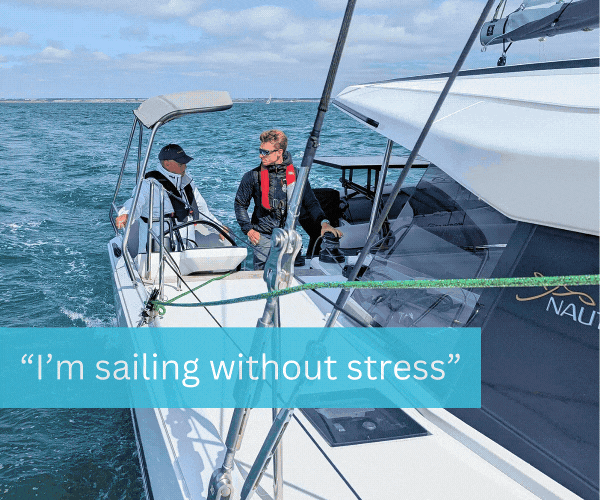Extreme 40 crash decision |
Post Reply 
|
Page <1 45678 9> |
| Author | ||
gordon 
Really should get out more 
Joined: 07 Sep 04 Online Status: Offline Posts: 1037 |
 Post Options Post Options
 Quote Quote  Reply Reply
 Topic: Extreme 40 crash decision Topic: Extreme 40 crash decisionPosted: 22 Sep 11 at 8:42am |
|
|
WHEN A broke rule 13, R took reasonable action by changing course. At this point A was on starboard but subject to rule 13. R was entitled to continue sailing her course without taking avoiding action, but could not do so because A had broken a rule.
When, subsequently, A compounded her error by failing to accelerate out of the tack, R took further action, which may have been ineffectual. It may well have been that the jib sheet crew's instinct was to tack, but the helmsman's instinct was to bear away. There was little or no time for a discussion! The rule only requires R to take action to avoid a collision - it does not oblige her to take any particular action, or to succeed. This case is about A making a risky decision to tack and failing to give R room to keep clear. Gordon |
||
|
Gordon
|
||
 |
||
Brass 
Really should get out more 
Joined: 24 Mar 08 Location: Australia Online Status: Offline Posts: 1151 |
 Post Options Post Options
 Quote Quote  Reply Reply
 Posted: 22 Sep 11 at 3:15pm Posted: 22 Sep 11 at 3:15pm |
|
Sorry, I can't agree with that.
Rule 14 (llike most of the post 1995 rules) imposes an outcome-based obligation, 'to avoid contact', with a limitation or condition 'if reasonably possible'. It does NOT mandate 'action to avoid contact'.
This may be contrasted with pre-1995 rule 32.1 which required a boat 'to make a reasonable attempt to avoid collision'.
Under rule 14 as it stands, if it becomes impossible for a boat to avoid contact, say because of a sudden round-up under her nose, she is not obliged to take any action or attempt to avoid for to not break the rule because of the impossibility.
|
||
 |
||
Scooby_simon 
Really should get out more 
Joined: 02 Apr 04 Location: United Kingdom Online Status: Offline Posts: 2415 |
 Post Options Post Options
 Quote Quote  Reply Reply
 Posted: 22 Sep 11 at 3:29pm Posted: 22 Sep 11 at 3:29pm |
|
You say A took a risky decision; IF R had sailed the boat properly there would have been no collision. Thus no risk by A; as I stated above; R failed to sail the boat correctly and by their ineffectual action, the collision occured. So; in the case; are you stating (and I do want to understand this) that as long as R does SOMETHING to avoid A when ROW boat; and there is a collision then R is OK, even if they do not do what is reasonably expected of them (so in this case to not dump the jib and to dump the main to aid the the bear off). When I saw this happen; as soon as they dumped the jib I knew they were in trouble; you can see the rudders stall and that's it; they are passengers to the scene of the accident.... |
||
|
Wanna learn to Ski - PM me..
|
||
 |
||
ob1 
Groupie 
Joined: 21 Feb 11 Online Status: Offline Posts: 72 |
 Post Options Post Options
 Quote Quote  Reply Reply
 Posted: 22 Sep 11 at 3:54pm Posted: 22 Sep 11 at 3:54pm |
|
|
Hi guys - I have been folowing this thread with interest. I think I understand both of the arguments being put. I think A felt under pressure to make the rounding and tacked slightly too early (thereby taking a risk) and this was at least part of the cause of A's slow and bad tack. I understand Simon's argument that if sailied differently (better), R might have successfully avoided the collision, but as the jury didn't seem to comment on the reasonablness of R's actions (unless you know differently), I certainly don't think any precident has been set regarding anticipating whether a boat will be sailed reasonably or in a seamanlike manner or whether it will be sailed badly.
Edited by ob1 - 22 Sep 11 at 3:55pm |
||
 |
||
gordon 
Really should get out more 
Joined: 07 Sep 04 Online Status: Offline Posts: 1037 |
 Post Options Post Options
 Quote Quote  Reply Reply
 Posted: 22 Sep 11 at 4:21pm Posted: 22 Sep 11 at 4:21pm |
|
|
If a Jury had decided that R did not act to avoid contact with A when it became clear that A was not keeping clear that would not change the fact that A broke rule 13. However, we have established that she did take avoiding action. It could be argued that she took avoiding action twice, once by bearing away to pass behind a boat (A) that should accelerate on the new tack and then a further bear away to pass behind A when it was clear that A had stalled. The second bear away was reasonable but unsuccesful.
Question, on these boats, with the wind as it was, how long does it take to dump the main? |
||
|
Gordon
|
||
 |
||
tornado435 
Posting king 
Joined: 05 May 06 Location: United Kingdom Online Status: Offline Posts: 196 |
 Post Options Post Options
 Quote Quote  Reply Reply
 Posted: 22 Sep 11 at 4:57pm Posted: 22 Sep 11 at 4:57pm |
|
|
Not that long, its on hydraulics with a special dump button.
Only issue could have been if the Hydraulic selector wasn't on main but on cunningham or traveller.
|
||
 |
||
Scooby_simon 
Really should get out more 
Joined: 02 Apr 04 Location: United Kingdom Online Status: Offline Posts: 2415 |
 Post Options Post Options
 Quote Quote  Reply Reply
 Posted: 22 Sep 11 at 5:06pm Posted: 22 Sep 11 at 5:06pm |
|
BUT Gordon; I would argue that neither part of the bear-away were "reasonable" BECAUSE they dumped the Jib and did not dump the mainsail. Were there any cat sailors on the jury? If I have been on A; I would have argued that it is common knowledge that you MUST NOT dump the jib when trying to bear off and so they DID NOT take reasonable action to avoid. IF sail handling and "reasonable" does not mean "common practice" then this makes the burdon on A massive as they HAVE to assume that the boat may attemp to bear off; dump the jib and thus carry on on a very similar heading.... OR the boat may attempt to head up (to slow and/or to tack). and fail to do so as well........ |
||
|
Wanna learn to Ski - PM me..
|
||
 |
||
gordon 
Really should get out more 
Joined: 07 Sep 04 Online Status: Offline Posts: 1037 |
 Post Options Post Options
 Quote Quote  Reply Reply
 Posted: 22 Sep 11 at 6:19pm Posted: 22 Sep 11 at 6:19pm |
|
|
1 These races were umpired I believe. There may have been a rule 14 hearing;
2 If you study the video carefully the main sheet on R is trimmed out at least twice - you can see a clear flick as this happens. The jib is trimmed at same time. On one of these trims jib flogs and is instantly resheeted. 3 I hope we are all agreed that A broke rule 13. I am satisfied that R took action as soon as it was clear that A was not keeping clear, but were surprised when A's poor tack meant that A stalled. You are not satisfied that this is the case. A good illustration of why there are members of a protest committee, and 5 on an international jury. Decisions are not always unanimous. Gordon |
||
|
Gordon
|
||
 |
||
JimC 
Really should get out more 

Joined: 17 May 04 Location: United Kingdom Online Status: Offline Posts: 6662 |
 Post Options Post Options
 Quote Quote  Reply Reply
 Posted: 22 Sep 11 at 7:12pm Posted: 22 Sep 11 at 7:12pm |
|
Yes, the burden on A is massive. They may not tack unless they can be sure that they can complete the tack before the boat behind has to *start* taking avoiding action. Ahead but to leeward and needing to tack is not a good place to be on the approach to a windward mark. The video makes it clear that this is particularly the case with these ultra fast multihulls. Edited by JimC - 22 Sep 11 at 7:35pm |
||
 |
||
Skiffman 
Far too distracted from work 

Joined: 27 May 04 Location: United Kingdom Online Status: Offline Posts: 291 |
 Post Options Post Options
 Quote Quote  Reply Reply
 Posted: 24 Sep 11 at 10:38pm Posted: 24 Sep 11 at 10:38pm |
|
|
Interesting read what everyone thinks, personally it is not clear cut and a different jury would probably find a different outcome. This is certainly in the grey area for more than one reason.
Personally I think there are a few things that have probably gone unsaid that hugely effected the decisions of the crew on R. First of all A has tacked tight on the lay. R does not want to tack below as they will get rolled and miss the mark. Tacking a 40 is much easier than a duck, a tack in this situation would most likely of not caused any problem. So next thing is that if R starts to duck early and makes it look very hard, the jury could penelise A. Think of the Greece duck on Ben a few years ago, Now R has started to duck but A has not done a great tack, R still wants to make it look close but at the same time wants to be in a situation to be able to tack straight after the duck. As said the 40 has a dump valve on the mainsheet where all the pressure gets released instantly. If the button had been pressed and the main released there would not have been a collision. Why was the button not pressed? First off they could have tried and it failed or it could have not been on the mainsheet but on the cunningham etc. Then playing devils advocate, what if R did not want to press the dump valve because if they did they would not be able to tack straight after the duck. Therefore putting them further behind... At the end of the day you do not know exactly what went on, but has opened up how much room you need to avoid in future decisions. Just for reference for me I think its 50/50 as I do not know the whole story and nor am I an international jury. Also I do not know what is a seamanlike way of avoiding contact is in a 40. The whole thing is really interesting because often happens in 49ers but I do not think before seeing the jurys decision on this you could ever go to protest being R. Although the one thing that is very difficult is what seamanlike for the top guys is not going to seamanlike for the back markers... Edited by Skiffman - 24 Sep 11 at 10:47pm |
||
 |
||
Post Reply 
|
Page <1 45678 9> |
| Forum Jump | Forum Permissions  You cannot post new topics in this forum You cannot reply to topics in this forum You cannot delete your posts in this forum You cannot edit your posts in this forum You cannot create polls in this forum You cannot vote in polls in this forum |
Bulletin Board Software by Web Wiz Forums® version 9.665y
Copyright ©2001-2010 Web Wiz
Change your personal settings, or read our privacy policy
Copyright ©2001-2010 Web Wiz
Change your personal settings, or read our privacy policy












-(1)-202408140552.gif)












 Printable Version
Printable Version Delicious
Delicious Digg
Digg Facebook
Facebook Furl
Furl Google
Google MySpace
MySpace Newsvine
Newsvine reddit
reddit StumbleUpon
StumbleUpon Twitter
Twitter Windows Live
Windows Live Yahoo Bookmarks
Yahoo Bookmarks Topic Options
Topic Options